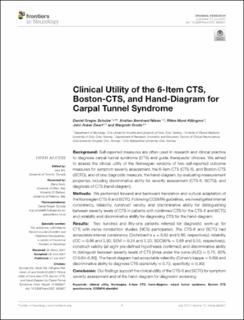| dc.contributor.author | Schulze, Daniel Gregor | |
| dc.contributor.author | Nilsen, Kristian Bernhard | |
| dc.contributor.author | Killingmo, Rikke Munk | |
| dc.contributor.author | Zwart, John Anker | |
| dc.contributor.author | Grotle, Margreth | |
| dc.date.accessioned | 2022-01-20T12:17:30Z | |
| dc.date.available | 2022-01-20T12:17:30Z | |
| dc.date.created | 2021-08-23T13:37:24Z | |
| dc.date.issued | 2021-07-27 | |
| dc.identifier.citation | Frontiers in Neurology. 2021, 12 1-10. | en_US |
| dc.identifier.issn | 1664-2295 | |
| dc.identifier.uri | https://hdl.handle.net/11250/2838472 | |
| dc.description.abstract | Background: Self-reported measures are often used in research and clinical practice to diagnose carpal tunnel syndrome (CTS) and guide therapeutic choices. We aimed to assess the clinical utility of the Norwegian versions of two self-reported outcome measures for symptom severity assessment, the 6-item CTS (CTS-6), and Boston-CTS (BCTQ), and of one diagnostic measure, the hand-diagram, by evaluating measurement properties including discriminative ability for severity assessment (CTS-6, BCTQ), and diagnosis of CTS (hand-diagram).
Methods: We performed forward and backward translation and cultural adaptation of the Norwegian CTS-6 and BCTQ. Following COSMIN guidelines, we investigated internal consistency, reliability, construct validity, and discriminative ability for distinguishing between severity levels of CTS in patients with confirmed CTS for the CTS-6 and BCTQ and reliability and discriminative ability for diagnosing CTS for the hand-diagram.
Results: Two hundred and fifty-one patients referred for diagnostic work-up for CTS with nerve conduction studies (NCS) participated. The CTS-6 and BCTQ had acceptable internal consistency (Crohnbach’s α = 0.82 and 0.86, respectively), reliability (ICC = 0.86 and 0.90; SEM = 0.24 and 0.20; SDC95% = 0.68 and 0.55, respectively), construct validity (all eight pre-defined hypotheses confirmed) and discriminative ability to distinguish between severity levels of CTS [Area under the curve (AUC) = 0.75, 95% CI 0.64–0.85]. The hand-diagram had acceptable reliability (Cohen’s kappa = 0.69) and discriminative ability to diagnose CTS (sensitivity = 0.72, specificity = 0.90).
Conclusion: Our findings support the clinical utility of the CTS-6 and BCTQ for symptom severity assessment and of the hand-diagram for diagnostic screening. | en_US |
| dc.language.iso | eng | en_US |
| dc.publisher | Frontiers Media | en_US |
| dc.relation.ispartofseries | Frontiers in Neurology;July 2021 | Volume 12 | Article 683807 | |
| dc.rights | Navngivelse 4.0 Internasjonal | * |
| dc.rights.uri | http://creativecommons.org/licenses/by/4.0/deed.no | * |
| dc.subject | Clinical utilities | en_US |
| dc.subject | Norwegian language | en_US |
| dc.subject | 6-item carpal tunnel syndrome | en_US |
| dc.subject | Hand-diagrams | en_US |
| dc.subject | Boston carpal tunnel syndrome questionnaires | en_US |
| dc.subject | COSMIN checklist | en_US |
| dc.title | Clinical Utility of the 6-Item CTS, Boston-CTS, and Hand-Diagram for Carpal Tunnel Syndrome | en_US |
| dc.type | Peer reviewed | en_US |
| dc.type | Journal article | en_US |
| dc.description.version | publishedVersion | en_US |
| dc.rights.holder | © 2021 Schulze, Nilsen, Killingmo, Zwart and Grotle. | en_US |
| dc.source.articlenumber | 683807 | en_US |
| cristin.ispublished | true | |
| cristin.fulltext | original | |
| cristin.qualitycode | 1 | |
| dc.identifier.doi | https://doi.org/10.3389/fneur.2021.683807 | |
| dc.identifier.cristin | 1928045 | |
| dc.source.journal | Frontiers in Neurology | en_US |
| dc.source.volume | 12 | en_US |
| dc.source.pagenumber | 1-10 | en_US |

